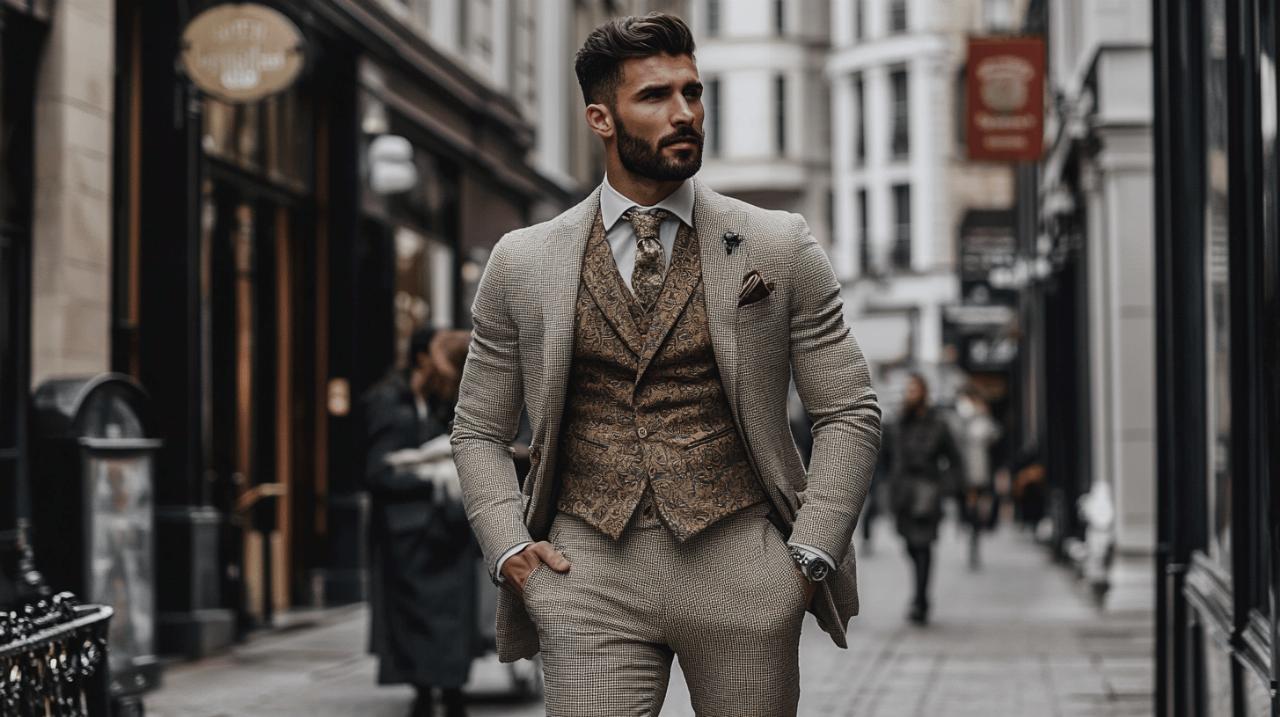The art of dressing well has long been a pursuit cherished by those who understand that true elegance transcends fleeting trends and speaks to something far more enduring. For the modern British gentleman seeking to embody the refined sophistication of the dandy, the journey involves a careful balance of classic sartorial principles and contemporary sensibility. This approach to personal style is not merely about donning expensive garments but about cultivating an aesthetic that reflects character, attention to detail, and an appreciation for the finer points of men's fashion.
Building your dandy wardrobe: the essential sartorial foundations
Establishing a wardrobe worthy of the dandy epithet begins with understanding the fundamentals of quality and versatility. Rather than chasing every seasonal whim, the discerning gentleman invests in pieces that form the backbone of a coherent and elegant wardrobe. A capsule wardrobe approach proves invaluable here, focusing on versatile clothing that can be mixed and matched to create a variety of sophisticated ensembles. The emphasis should always be on fit and quality, as these two elements underpin every successful sartorial choice. A well-curated collection need not be extensive, but each piece must earn its place through both its construction and its ability to work harmoniously with the rest of the wardrobe.
The colour palette forms the canvas upon which the dandy paints his daily presentation. A neutral colour palette centred around shades such as navy, charcoal, beige, black, and white provides endless possibilities without overwhelming the eye. These tones serve as the foundation, allowing for subtle variations and the occasional accent in forest green or burgundy. Light grey offers a softer alternative for warmer months, whilst maintaining the sophisticated restraint that defines the dandy aesthetic. This restrained approach to colour ensures that attention remains on the cut, fabric, and overall silhouette rather than being distracted by bold patterns or jarring hues.
Selecting the Proper Suit: Cut, Cloth, and Character
The suit remains the cornerstone of any gentleman's wardrobe, and selecting the right one demands careful consideration. The cut must complement your natural physique whilst adhering to timeless principles of proportion. Whether opting for a classic British cut with its structured shoulders and nipped waist or a slightly more relaxed Continental style, the key lies in achieving a silhouette that flatters without appearing contrived. The cloth itself speaks volumes about the wearer's discernment. Fine wool, perhaps with a subtle herringbone or birdseye weave, offers both visual interest and practical durability. A well-maintained suit can last seven to ten years, making it not merely a purchase but an investment in one's personal presentation.
Character in a suit emerges from the details. The lapel width should balance the jacket's overall proportions, whilst the button stance determines the jacket's visual length. Trouser breaks, cuff styles, and lining choices all contribute to the final impression. The dandy understands that a suit is not simply a uniform but a canvas for self-expression within the bounds of good taste. This is where the influence of period styling, such as the sharply tailored aesthetic seen in post-war British elegance, can inform contemporary choices without descending into costume.
Mastering Shirt and Tie Combinations: Patterns, Textures, and Proportions
The interplay between shirt and tie presents an opportunity for subtle creativity within the framework of refinement. A core collection of five to seven ties in varying patterns and textures provides sufficient variety without overwhelming the wardrobe. Stripes, dots, paisleys, and solid colours each have their place, and understanding when to deploy each demonstrates true sartorial fluency. The texture of the tie, whether silk, wool, or linen, should complement the season and the occasion, whilst the width must harmonise with the lapel of the jacket.
Shirts form the canvas upon which the tie performs, and their selection requires equal care. Classic white and light blue provide versatility, whilst subtle patterns such as fine checks or stripes add visual interest without competing with the tie. The collar style must accommodate the tie knot and frame the face appropriately. Proportions matter enormously in these combinations. A narrow tie demands a more compact knot and a slimmer collar spread, whilst a wider tie benefits from a fuller knot and broader collar. The dandy considers these relationships instinctively, creating harmonious compositions that appear effortless.
The Art of Grooming and Personal Presentation
No amount of sartorial excellence can compensate for neglected grooming. The dandy understands that personal presentation extends beyond clothing to encompass every visible aspect of one's appearance. This holistic approach to grooming separates the merely well-dressed from the truly distinguished gentleman. Regular attention to these details ensures that the overall impression remains one of careful cultivation rather than accidental assembly.
Crafting the Perfect Barnet: Classic Cuts and Contemporary Styling
The haircut one chooses frames the face and sets the tone for the entire presentation. Classic cuts that have stood the test of time offer reliability and refinement. The side parting, for instance, has graced the heads of gentlemen for generations and continues to project an air of traditional elegance. Contemporary styling products allow for subtle variations on these themes, providing hold and texture without the stiffness of older formulations. The key lies in selecting a style that complements your face shape and lifestyle whilst maintaining the polished appearance that defines the dandy aesthetic.
Regular visits to a skilled barber ensure that the cut maintains its shape between appointments. The relationship between a gentleman and his barber resembles that between an artist and his patron, built on trust and mutual understanding. This professional relationship yields consistent results and allows for subtle refinements over time. The modern dandy need not sport an elaborate coiffure but must ensure that whatever style he adopts appears intentional and well-maintained.
Facial Hair Finesse: Maintaining the Distinguished Beard or Moustache
Facial hair, when properly maintained, adds character and gravitas to a gentleman's appearance. Whether sporting a full beard, a neatly trimmed moustache, or remaining clean-shaven, the decision must be followed through with commitment and care. A beard requires regular trimming to maintain its shape, along with conditioning treatments to keep the hair soft and manageable. The neckline and cheek lines demand particular attention, as imprecise boundaries undermine the overall effect.
The moustache presents its own challenges and rewards. Styles ranging from the subtle pencil to the more dramatic handlebar each require specific maintenance routines. Waxes and oils become essential tools in the dandy's grooming arsenal, allowing for precise styling and conditioning. The choice of facial hair style should complement both the face shape and the overall aesthetic one wishes to project. Regular maintenance ensures that facial hair remains an asset rather than becoming a distraction from an otherwise impeccable presentation.
Accessorising with Purpose: The Details That Define the Dandy
 The maxim that accessories should be used sparingly reflects an understanding that these elements serve to enhance rather than overwhelm. Each accessory must be chosen with purpose and worn with confidence. The dandy recognises that these finishing touches distinguish the complete ensemble from the merely adequate. Quality trumps quantity in this realm, as a few well-chosen pieces prove far more effective than an abundance of mediocre adornments.
The maxim that accessories should be used sparingly reflects an understanding that these elements serve to enhance rather than overwhelm. Each accessory must be chosen with purpose and worn with confidence. The dandy recognises that these finishing touches distinguish the complete ensemble from the merely adequate. Quality trumps quantity in this realm, as a few well-chosen pieces prove far more effective than an abundance of mediocre adornments.
Pocket watches, cufflinks, and tie pins: the gentleman's finishing touches
The pocket watch represents the epitome of refined timekeeping, offering both functionality and aesthetic appeal. Whether opting for a traditional mechanical movement or a more practical quartz mechanism, the watch itself should feature a handsome case and a clear, legible dial. The chain, whether attached to a waistcoat button or worn across the front, adds a subtle flourish that speaks to attention to detail. In contexts where a wristwatch proves more appropriate, the same principles apply: choose quality, clarity, and restraint over ostentation.
Cufflinks transform the mundane act of fastening cuffs into an opportunity for personal expression. Simple designs in precious metals suit most occasions, whilst more elaborate pieces featuring enamel or gemstones can be reserved for evening wear or special events. The tie pin serves both a practical purpose in keeping the tie in place and an aesthetic function in adding a subtle accent to the ensemble. Again, restraint proves key, as overly ornate pieces risk appearing gauche rather than refined.
Footwear and Headwear: Completing the Ensemble from Top to Toe
The importance of footwear in completing a gentleman's outfit cannot be overstated. Shoes form the foundation of the ensemble and must be chosen with care. Classic styles such as the Oxford, Derby, and brogue have endured because they combine elegance with versatility. The leather should be of fine quality, the construction solid, and the maintenance regular. Well-polished shoes project an image of competence and attention to detail that extends beyond mere fashion.
Headwear adds a final layer of sophistication when appropriately deployed. The top hat, whilst rare in contemporary settings, retains its place for the most formal occasions. More practical alternatives such as the fedora, trilby, or flat cap offer protection from the elements whilst enhancing the overall aesthetic. The key lies in selecting styles that complement both the face shape and the formality of the occasion. A hat worn with confidence elevates an ensemble, whilst one worn awkwardly undermines it. Materials such as felt, tweed, and straw each suit different seasons and contexts, allowing the discerning gentleman to maintain his refined appearance throughout the year.
Drawing Inspiration from Iconic Figures and Modern Interpretations
The dandy tradition benefits enormously from the rich tapestry of cultural references available to the modern gentleman. By studying the sartorial choices of iconic figures, both historical and contemporary, one gains insight into the principles that underpin enduring style. This process of inspiration and adaptation allows for personal expression within a framework of established excellence.
Channelling the Shelby Brothers: Peaky Blinders and Post-War British Elegance
The visual impact of period drama has introduced a new generation to the sharp tailoring and bold confidence of early twentieth-century British style. The look popularised by such programmes emphasises structured suits with peaked lapels, high-waisted trousers, and substantial overcoats. Whilst the complete ensemble might prove too theatrical for everyday wear, elements can be successfully incorporated into a modern wardrobe. The attention to detail in accessories, particularly the use of tie pins, pocket watches, and substantial footwear, offers valuable lessons in creating a cohesive and impactful presentation.
This aesthetic draws much of its power from its association with working-class aspiration and the democratisation of fine dressing. The notion that any man, regardless of background, can achieve distinction through careful attention to his appearance resonates strongly with the democratic spirit of the dandy tradition. By adapting these historical elements to contemporary contexts, the modern gentleman can evoke the confidence and presence of these characters without descending into costume.
Borrowing Boldness: Lessons from Bowie, Ralph Lauren, and Silver Screen Legends
Musical and cinematic icons have long influenced men's fashion, offering templates for bold self-expression within sartorial frameworks. David Bowie, throughout his chameleonic career, demonstrated that dandyism could encompass both tradition and innovation, blending classic tailoring with unexpected elements. His fearless approach to personal style reminds us that the dandy need not be constrained by rigid conventions but can interpret them through a personal lens.
Ralph Lauren built an empire on the notion of aspirational elegance, drawing from British and American sartorial traditions to create a coherent aesthetic that speaks to timeless refinement. His emphasis on quality, craftsmanship, and attention to detail mirrors the values that underpin the dandy approach. Silver screen legends from various eras, whether embodying gangster elegance like Tony Montana or suave sophistication in countless other roles, provide visual reference points for different aspects of masculine style. By studying these figures and extracting the principles behind their memorable appearances, the modern gentleman can develop his own distinctive interpretation of the dandy aesthetic.
Literary figures such as Oscar Wilde and Lord Byron established the intellectual and cultural foundations of dandyism, demonstrating that this approach to dress and deportment extends beyond mere vanity to encompass a philosophy of life. Their influence persists in contemporary fashion, reminding us that the dandy tradition values wit, culture, and individuality alongside sartorial excellence. Even fictional characters like Dorian Gray continue to inspire with their commitment to aesthetic perfection, however cautionary their tales might be in other respects.
The modern dandy draws from this rich well of influences whilst remaining firmly rooted in the present. He understands that style evolves whilst certain principles remain constant. By balancing respect for tradition with openness to contemporary interpretation, he creates a personal aesthetic that feels both timeless and relevant. This synthesis of past and present, of classic technique and modern sensibility, defines the true art of perfecting the dandy style and look for today's discerning British gentleman.

